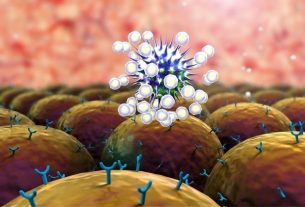The different types of lupus are discoid lupus, systemic lupus erythematosus, drug-induced lupus, and neonatal lupus. Symptoms of lupus include skin lesions, hair loss, joint swelling and pain, fever and, in some cases, kidney, heart and blood problems.
Lupus is an autoimmune disease where defense cells attack healthy cells in the body, which can cause inflammation in various parts of the body, such as joints, skin, kidneys, heart, lungs and brain.
Read too: Lupus: what it is, symptoms, types, causes and treatment
Lupus treatment must be carried out by a rheumatologist, who may recommend the use of sunscreen, ointments and creams with corticosteroids or immunosuppressants, oral non-steroidal anti-inflammatory drugs and, in some cases, blood transfusion.

The 4 types of lupus are:
1. Discoid lupus
Discoid lupus, or discoid lupus erythematosus, is a chronic inflammatory disease caused by a change in the immune system that attacks the body’s own healthy cells, resulting in inflammation of the skin and the emergence of symptoms. Learn more about discoid lupus.
Symptoms: the main symptoms of this type of lupus are round, red and scaly lesions on the skin, mainly on the face, ear, scalp and back of the neck, skin sensitivity to the sun and loss of hair in the region of the lesions.
Treatment: the rheumatologist may prescribe the use of sunscreen, ointments containing corticosteroids and/or immunosuppressants, injections of corticosteroids directly into the lesions.
In addition, the doctor may also recommend the use of oral medications, such as hydroxychloroquine, azathioprine, methotrexate and thalidomide, for example.
Don’t ignore the signs your body is giving you!
2. Systemic lupus erythematosus
Systemic lupus erythematosus (SLE) is the most common type of lupus, characterized by chronic autoimmune inflammation in various parts and organs of the body, such as the skin, blood, joints, heart, kidneys and lungs.
Symptoms: People with this type of lupus may experience rashes, hair loss, sun sensitivity, joint swelling and pain, low-grade fever, fatigue, and kidney problems.
Due to inflammation in the skin, nervous system and blood vessels, systemic lupus erythematosus can also cause memory problems, confusion, headaches, seizures, heart attack, lupus nephritis and ulcers throughout the body.
Read too: Lupus nephritis: what it is, symptoms, causes and treatment
Treatment: Ointments or creams with corticosteroids or calcineurin inhibitors may be indicated to treat skin lesions. The doctor may also prescribe the use of oral or intravenous medications, such as hydroxychloroquine, corticosteroids, cytotoxic drugs, immunosuppressants, anticoagulants, depending on the signs and symptoms presented.
In addition, lifestyle changes are also recommended, such as using sunscreen and light, loose-fitting, dark clothing covering most of the body, practicing stress reduction techniques, good sleep hygiene and physical exercise, stopping smoking, avoiding consume alfalfa sprouts and echinacea, and maintain a diet rich in vitamin D.
Read too: Lupus diet: what to eat and what to avoid (with menu)
3. Drug-induced lupus
Drug-induced lupus can be caused by medications such as statins, antiarrhythmics, proton pump inhibitors, gold salts, nonsteroidal anti-inflammatory drugs, oral contraceptives, procainamide, hydralazine, interferon-alpha, minocycline, isoniazid, rifampicin, phenytoin, penicillamine, quinidine, phenytoin, methyldopa, chlorpromazine and carbamazepine, for example.
Additionally, some herbal medicines, such as alfalfa sprouts, echinacea, and melatonin, have also been linked to lupus flares.
Symptoms: Symptoms of drug-induced lupus may appear within a few weeks to several months after starting the medication, including skin lesions, joint and muscle pain, fever, and weight loss. Most of the time, symptoms usually disappear within a few weeks of stopping the medication.
Treatment: the main treatment is to stop using the medication that causes this condition. Your doctor may also prescribe the use of nonsteroidal anti-inflammatory drugs or corticosteroids to treat your symptoms.
4. Neonatal lupus
Neonatal lupus is a rare condition that can be caused by the transfer of some antibodies from a mother with lupus to her baby during pregnancy.
Symptoms: a baby with neonatal lupus may present symptoms and signs, such as lesions on the head, trunk and extremities of the body, liver problems, anemia, neutropenia, thrombocytopenia, macrocephaly, congestive heart failure, myocarditis and cardiac arrhythmias.
Treatment: Laser therapy may be recommended by your doctor to treat skin lesions. Blood and platelet transfusions can be prescribed to treat anemia and thrombocytopenia. Glucocorticoid medications or intravenous immunoglobulin may also be indicated in some cases.
Additionally, treatment with 400 mg of hydroxychloroquine daily between 6 and 10 weeks of pregnancy may reduce the risk of the baby developing cardiac lupus.
How lupus is diagnosed
The diagnosis of lupus is made by a rheumatologist by evaluating the signs and symptoms presented, the person’s health history and physical examination.
To confirm the diagnosis, the doctor recommends carrying out laboratory tests, such as blood count and urine tests, chest x-ray and more specific tests to assess the presence of antibodies related to this disease, such as the antinuclear antibody test, anti-DNA antibodies. double strand, anti-Smith antibodies and antiphospholipid antibodies, for example.
Read too: FAN exam: what it is, what it is for and results

Sign up for our newsletter and stay up to date with exclusive news
that can transform your routine!
Warning: Undefined array key "title" in /home/storelat/public_html/wp-content/plugins/link-whisper-premium/templates/frontend/related-posts.php on line 12
Warning: Undefined array key "title_tag" in /home/storelat/public_html/wp-content/plugins/link-whisper-premium/templates/frontend/related-posts.php on line 13



